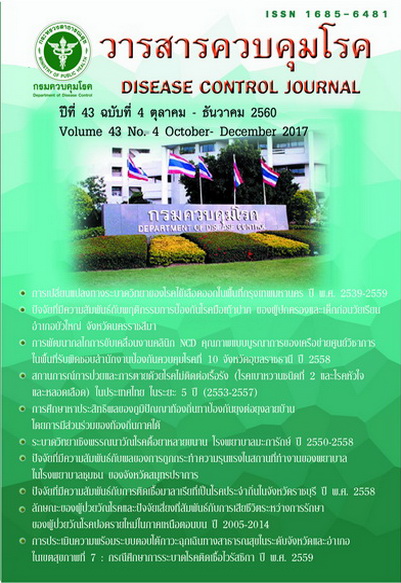Changing epidemiology of dengue diseases in 1996-2016, Bangkok, Thailand
DOI:
https://doi.org/10.14456/dcj.2017.1Keywords:
epidemiology, dengue diseases, BangkokAbstract
This study was a descriptive study. The objectives were to describe the epidemiological changes of dengue in Bangkok during 1996-2016, and to determine the correlation between the morbidity rate and the meteorological factors. We analyzed the secondary data from the disease reporting system and the Thai Meteorological Department. The data of patients who had address in Bangkok and diagnosed or coded as any kind of dengue diseases during 1 January 1996 to 30 September 2016 were recruited. The data were analyzed by descriptive statistics; percentage, mean, median, rate, ratio and correlation. The results found that there were 192,613 dengue cases. The morbidity rate was 35.47-461.19 per 100,000 population per year. The case fatality rate was 0-0.18%. The increasing trend in the age-group of ≥15 year old was clearly, especially in 2001-2016. The morbidity rate by age-group of 10-14 and ≤9 year olds were unchanged and decreased. There was no correlation between mean age of dengue case and mean age of population (r = -0.22, 95% CI = -0.69 to 0.38, p=0.47). The dengue ratio in males was higher than in females. The fluctuations in the diseases cycle was uncertain pattern during 2005-2016, which different from 1996-2004 that 2 years of outbreak space 2 years of free outbreak. Since 2010, the morbidity rate was low in May and increased in July but before 2010 it was low in April and increased in June. The morbidity rate of the dengue was linearly correlated with rainfall (r = 0.18, 95% CI = 0.05 to 0.29, p=0.01), temperature (r = -0.18, 95% CI = -0.30 to -0.06, p=0.00) and relative humidity was statistically significant (r = 0.20, 95% CI = 0.08 to 0.32, p=0.00). In 2003-2015, there were 35 districts with repetitive outbreaks from all 50 districts. The morbidity rate by districts was linearly correlated with population density (r = 0.08, 95% CI = 0.01 to 0.16, p=0.03). The most type of dengue cases were DHF (51.26-92.59%) followed by DF (6.69-48.49%) and DSS (0.25-0.83%). In 2009-2015, trends of DF was increasing, but it was decreasing for DHF. Health sectors and staff should run prevention and control activities in line with the changing epidemic season. Special surveillance should be taken in the repeated outbreak areas. The physicians have to aware of dengue diseases in adult and should recognized that DF patients will present with nonspecific symptoms.
Downloads
References
2. สำนักโรคติดต่อนำโดยแมลง.คู่มือวิชาการโรคติดเชื้อเด็งกีและโรคไข้เลือดออกเด็งกีด้านการแพทย์และสาธารณสุข. กรุงเทพมหานคร: อักษร กราฟฟิค แอนด์ ดีไซน์; 2558.
3. สำนักระบาดวิทยา. รายงานโรคในระบบเฝ้าระวัง 506 DHF total [อินเทอร์เน็ต]. [สืบค้นเมื่อ 10 เม.ย. 2559]. แหล่งข้อมูล: http :// www . boe. moph.go.th/boedb/surdata/506wk/y58/ d262766_5258.pdf
4. Chareonsook O, Foy HM, Teeraratkul A, Silarug N. Changing epidemiology of dengue hemorrhagic fever in Thailand. Epidemiol Infect 1999;122: 161-6.
5. Limkittikul K, Brett J, L’Azou M. Epidemiological trends of dengue disease in Thailand (2000- 2011): a systematic literature review. PLoS Negl Trop Dis 2014;8:e3241.
6. กรกช วิจิตรจรัสแสง. สถานการณ์และปัจจัยสภาพ แวดล้อมที่เกี่ยวข้องกับการระบาดของโรคไข้ เลือดออกจังหวัดลำปาง ระหว่างปี 2546-2555 [การค้นคว้าแบบอิสระปริญญาสาธารณสุขศาสตร มหาบัณฑิต]. เชียงใหม่: มหาวิทยาลัยเชียงใหม่; 2557. 76 หน้า.
7. Tanayapong S, Pengsaa K, Thisyakorn U. Changing epidemiology of dengue patients in Ratchaburi, Thailand. Asian Biomed 2013;7:561-6.
8. ศิริชัย วงศ์วัฒนไพบูลย์. การศึกษาระบาดวิทยาโรค ไข้เลือดออกในประเทศไทย การพยากรณ์และแนวทาง ป้องกันควบคุมโรค. รายงานการเฝ้าระวังทางระบาด วิทยาประจำสัปดาห์ 2550;38:613-8.
9. Tipayamongkholgul M, Fang CT, Klinchan S, Liu CM, King CC. Effects of the El Niño-southern oscillation on dengue epidemics in Thailand, 1996-2005. BMC Public Health 2009;9:422.
10. เสรี นพรัตน์. ระบาดวิทยาของโรคไข้เลือดออกใน จังหวัดอุตรดิตถ์ [การค้นคว้าแบบอิสระปริญญา สาธารณสุขศาสตรมหาบัณฑิต]. เชียงใหม่: มหาวิทยาลัย เชียงใหม่; 2543. 100 หน้า.
11. กลุ่มระบาดวิทยาและข่าวกรอง สำนักงานป้องกัน ควบคุมโรคที่ 1 กรุงเทพมหานคร. รายงานการ พยากรณ์โรคปี 2557. กรุงเทพมหานคร: ซีนิธกรุ๊ป; 2557.
12. อุษาวดี ถาวระ. ยุงชอบกัดคนประเภทไหน [อินเทอร์เน็ต]. [สืบค้นเมื่อ 17 มี.ค. 2560]. แหล่ง ข้อมูล:http://webdb.dmsc.moph.go.th/ifc_nih /a_nih_1_001c.asp?info_id=378
13. Bhatia R, Dash AP, Sunyoto T. Changing epide¬miology of dengue in South-East Asia. WHO South-East Asia Journal of Public Health 2013;2:23-7.
Downloads
Published
How to Cite
Issue
Section
License
Articles published in the Disease Control Journal are considered as academic work, research or analysis of the personal opinion of the authors, not the opinion of the Thailand Department of Disease Control or editorial team. The authors must be responsible for their articles.






